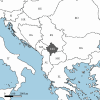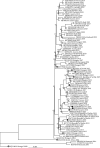First Detection of West Nile Virus (WNV) Lineage 2 in Mosquitoes in the Republic of Kosovo
- PMID: 40599430
- PMCID: PMC12213049
- DOI: 10.1155/tbed/3208806
First Detection of West Nile Virus (WNV) Lineage 2 in Mosquitoes in the Republic of Kosovo
Abstract
West Nile virus (WNV, family Flaviviridae) is the most geographically widespread arbovirus affecting humans. It circulates between wild birds and mosquitoes, while humans and horses are dead-end hosts. In recent years, several outbreaks have been reported from European countries, including the Balkan Peninsula. In the Republic of Kosovo, a southern Balkan country, data on WNV are scarce, and neither mosquito monitoring nor WNV surveillance is established. To address this gap, we aimed to assess a first monitoring approach that should set the basis and support future large-scale activities in the country. Mosquito sampling was performed from May to September 2022 in a peri-urban area in the western part of the capital city Prishtina, Republic of Kosovo. Collected mosquitoes were pooled, homogenized, and total nucleic acid was extracted. A WNV-DENV-ZIKV-specific multiplex RT-qPCR was applied, and WNV-positive samples were confirmed by RT-PCR and whole-genome sequencing. Of 44 screened pools, one pool molecularly identified as Culex pipiens f. pipiens was positive for WNV RNA. Subsequent sequencing revealed WNV lineage 2, and phylogenetic analysis included our sample in a monophyletic clade consisting mostly of sequences from southeastern Europe. This finding represents the first detection of WNV in mosquitoes in Kosovo, and provides crucial baseline data for future vector-borne disease monitoring, and control efforts in Kosovo.
Keywords: Culex; Kosovo; West Nile virus; monitoring; phylogeny.
Copyright © 2025 Ina Hoxha et al. Transboundary and Emerging Diseases published by John Wiley & Sons Ltd.
Conflict of interest statement
The authors declare no conflicts of interest.
Figures



Similar articles
-
Re-Emergence of Usutu Virus and Spreading of West Nile Virus Neuroinvasive Infections During the 2024 Transmission Season in Croatia.Viruses. 2025 Jun 13;17(6):846. doi: 10.3390/v17060846. Viruses. 2025. PMID: 40573437 Free PMC article.
-
Vector surveillance of avian Plasmodium and West Nile virus in Culex mosquitoes from Doñana, a UNESCO World Heritage Site.Parasit Vectors. 2025 Aug 2;18(1):323. doi: 10.1186/s13071-025-06961-2. Parasit Vectors. 2025. PMID: 40753412 Free PMC article.
-
Spatial distribution of Culex mosquitoes across England and Wales, July 2023.Parasit Vectors. 2025 Aug 6;18(1):337. doi: 10.1186/s13071-025-06975-w. Parasit Vectors. 2025. PMID: 40770365 Free PMC article.
-
Significance of vertical transmission of arboviruses in mosquito-borne disease epidemiology.Parasit Vectors. 2025 Apr 9;18(1):137. doi: 10.1186/s13071-025-06761-8. Parasit Vectors. 2025. PMID: 40205559 Free PMC article.
-
Assessing the Relationship Between Entomological Surveillance Indices and West Nile Virus Transmission, United States: Systematic Review.Vector Borne Zoonotic Dis. 2025 May;25(5):317-328. doi: 10.1089/vbz.2024.0072. Epub 2025 Feb 13. Vector Borne Zoonotic Dis. 2025. PMID: 39943921
References
-
- World Health Organization. West Nile Virus. 2024. Available From https://www.who.int/news-room/fact-sheets/detail/west-nile-virus.
MeSH terms
LinkOut - more resources
Full Text Sources
Medical
Miscellaneous

